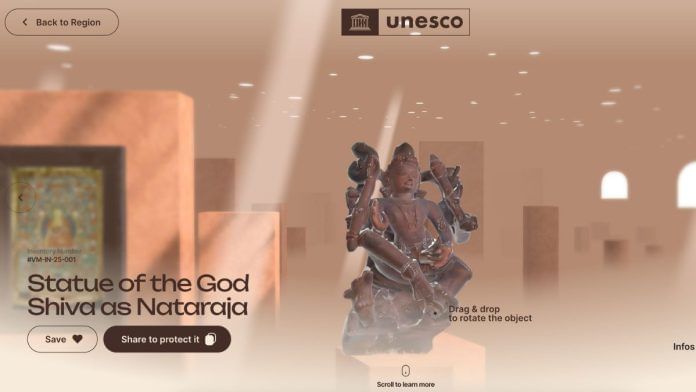New Delhi: The World’s first Virtual Museum of Stolen Cultural Objects established by UNESCO doesn’t want to expand its collection. It wants to shrink it.
“Unlike traditional museums, the Virtual Museum is designed to gradually empty itself with the goal of returning and not accumulating,” UNESCO said in a statement.
It was launched in this September at UNESCO’s MONDIACULT 2025 conference with an objective to deepen awareness about the illicit trafficking of cultural property and to provide an immersive experience accessible to all.
It is the first global platform dedicated to stolen objects.
“Cultural objects carry the stories of their communities. When a cultural object is stolen, we lose a part of our identity. When an object comes home, a story can begin again,” reads the museum website. Around 240 missing objects from 46 countries have been rendered in 2D and 3D, which visitors can browse for free.
It is funded by the Kingdom of Saudi Arabia and run in collaboration with Interpol and “a special contribution” from the US.
The museum includes cultural objects from manuscripts to sculptures and paintings and from different periods of history. There are three items from India on display—9th century sandstone sculptures of Nataraja and Brahma, and an undated stone sculpture of Bhairava.
The objects selected are among those listed in the INTERPOL stolen works of art database.
The creation of the museum was announced by UNESCO director-general Audrey Azoulay at the UNESCO World Conference on Cultural Policies and Sustainable Development – MONDIACULT 2022. The member states have been invited to select and showcase stolen objects that have cultural importance .
UNESCO—the United Nations Educational, Scientific and Cultural Organization—was formed in 1945 in the aftermath of World War II to promote peace and security through five programme areas: Education, natural sciences, social and human sciences, culture, and communication and information.
It is at the forefront of conservation of international culture, from protecting endangered languages to the identification and preservation of World Heritage sites. The virtual museum stems from the mission of UNESCO’s 1970 convention to prevent the theft and trafficking of cultural property.
Last year, UN General Assembly adopted a resolution helping strengthen the fight against illicit trafficking of cultural property and facilitating the restitution of stolen artifacts to their countries of origin
“When cultural goods are stolen, it is not just objects that disappear. It’s pieces of our history,” said Valdecy Urquiza, secretary general of INTERPOL while launching the virtual museum.
Also read: The afterlife of stolen antiquities when they are returned to India
Virtual architecture
The museum website is in the form of a baobab tree, which is a symbol of strength in the African continent. It was designed by Francis Kéré, a renowned architect from Burkina Faso.
According to UNESCO, like a mighty baobab tree, the museum will grow and evolve with the challenges, technologies and partnerships to come. “The ambition is that little by little, the Gallery of Stolen Objects will shrink as objects are recovered, while the Return and Restitution Room will grow with new inspiring stories of restituted objects. New thematic rooms will be created as opportunities arise, and these opportunities are as numerous as the number of partners concerned,” the website reads.
The Museum is focused on youth and digital natives, designed as an interactive and shareable space which invites visitors to explore and reflect.
The museum has five different categories of collection—ancient inscriptions and currencies, archaeological finds, architectural elements, artworks and ceremonial and ritual objects.
The website has three different rooms—the stolen cultural objects gallery, the Auditorium and the return and restitution room.
The items on display are divided by regions with 96 from Europe and North America, 57 from Latin America and the Caribbean, 51 from Africa, 37 from Asia and the Pacific and 36 from Arab countries.
Also read: A British man visits the National Museum and kicks off a debate on colonialism
Stolen goods
Once you select the Asia and the Pacific region, visitors can browse through the 37 objects. These include manuscripts, sculptures and even jewellery.
“Home to many cultures, languages and ways of life, the heritage of Asia and the Pacific shows a rich variety of traditions, knowledge and creative expressions that shape and sustain its societies. Some of its most precious objects were stolen and removed from their context of origin. In this room, you are invited to explore them and consider the worlds they evoke,” reads the description of the region.
In India, since the Modi government came to power, 610 stolen antiquities across the world have been recovered.
In 2023, PM Modi said that no museum in the world should hold on to any artwork acquired unethically.
“Before and after Independence, statues were taken out of our country in an unethical manner. With India’s growing reputation around the world, various countries have started returning its heritage to India,” he said.
(Edited by Theres Sudeep)






